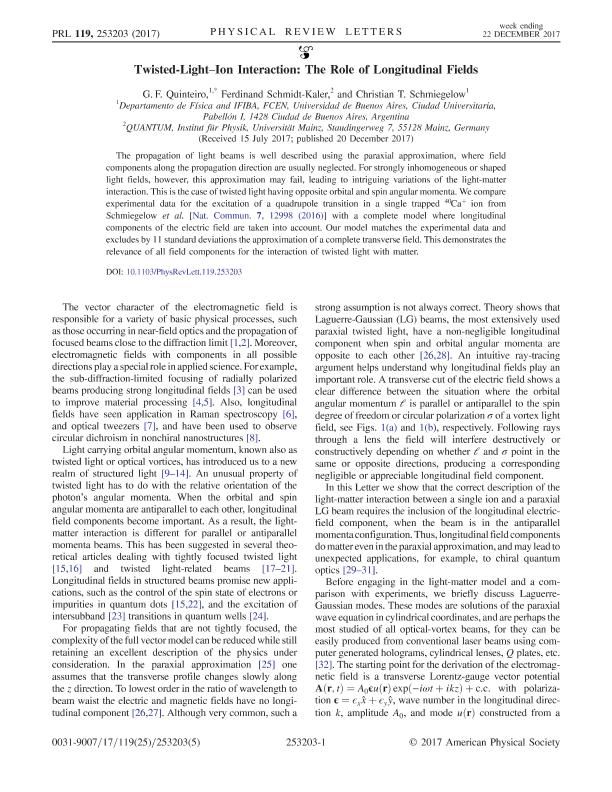Mostrar el registro sencillo del ítem
dc.contributor.author
Quinteiro, Guillermo Federico

dc.contributor.author
Schmidt-Kaler, Ferdinand
dc.contributor.author
Schmiegelow, Christian Tomás

dc.date.available
2018-08-15T18:32:40Z
dc.date.issued
2017-12
dc.identifier.citation
Quinteiro, Guillermo Federico; Schmidt-Kaler, Ferdinand; Schmiegelow, Christian Tomás; Twisted-Light-Ion Interaction: The Role of Longitudinal Fields; American Physical Society; Physical Review Letters; 119; 25; 12-2017; 253203-253203
dc.identifier.issn
0031-9007
dc.identifier.uri
http://hdl.handle.net/11336/55689
dc.description.abstract
The propagation of light beams is well described using the paraxial approximation, where field components along the propagation direction are usually neglected. For strongly inhomogeneous or shaped light fields, however, this approximation may fail, leading to intriguing variations of the light-matter interaction. This is the case of twisted light having opposite orbital and spin angular momenta. We compare experimental data for the excitation of a quadrupole transition in a single trapped Ca+40 ion from Schmiegelow et al. [Nat. Commun. 7, 12998 (2016)NCAOBW2041-172310.1038/ncomms12998] with a complete model where longitudinal components of the electric field are taken into account. Our model matches the experimental data and excludes by 11 standard deviations the approximation of a complete transverse field. This demonstrates the relevance of all field components for the interaction of twisted light with matter.
dc.format
application/pdf
dc.language.iso
eng
dc.publisher
American Physical Society

dc.rights
info:eu-repo/semantics/openAccess
dc.rights.uri
https://creativecommons.org/licenses/by-nc-sa/2.5/ar/
dc.subject
Haces Estructurados
dc.subject
Óptica Cuántica
dc.subject
Física Atomica
dc.subject.classification
Astronomía

dc.subject.classification
Ciencias Físicas

dc.subject.classification
CIENCIAS NATURALES Y EXACTAS

dc.title
Twisted-Light-Ion Interaction: The Role of Longitudinal Fields
dc.type
info:eu-repo/semantics/article
dc.type
info:ar-repo/semantics/artículo
dc.type
info:eu-repo/semantics/publishedVersion
dc.date.updated
2018-08-10T17:47:48Z
dc.journal.volume
119
dc.journal.number
25
dc.journal.pagination
253203-253203
dc.journal.pais
Estados Unidos

dc.journal.ciudad
Washington
dc.description.fil
Fil: Quinteiro, Guillermo Federico. Consejo Nacional de Investigaciones Científicas y Técnicas. Oficina de Coordinación Administrativa Ciudad Universitaria. Instituto de Física de Buenos Aires. Universidad de Buenos Aires. Facultad de Ciencias Exactas y Naturales. Instituto de Física de Buenos Aires; Argentina
dc.description.fil
Fil: Schmidt-Kaler, Ferdinand. University Mainz. Institute of Inorganic and Analytical Chemistry, Johannes Gutenberg; Alemania
dc.description.fil
Fil: Schmiegelow, Christian Tomás. Consejo Nacional de Investigaciones Científicas y Técnicas. Oficina de Coordinación Administrativa Ciudad Universitaria. Instituto de Física de Buenos Aires. Universidad de Buenos Aires. Facultad de Ciencias Exactas y Naturales. Instituto de Física de Buenos Aires; Argentina
dc.journal.title
Physical Review Letters

dc.relation.alternativeid
info:eu-repo/semantics/altIdentifier/doi/http://dx.doi.org/10.1103/PhysRevLett.119.253203
dc.relation.alternativeid
info:eu-repo/semantics/altIdentifier/url/https://link.aps.org/doi/10.1103/PhysRevLett.119.253203
Archivos asociados
